Are you a Quiet Speculation member?
If not, now is a perfect time to join up! Our powerful tools, breaking-news analysis, and exclusive Discord channel will make sure you stay up to date and ahead of the curve.
Welcome to week three of the Eldrazi Apocalypse! On Monday, I tried to distract us with promises of greener April pastures, but even the most indefatigable Modern optimist struggled to forget the weekend's horrors. StarCityGames' Louisville Classic was one of the ugliest Modern events I've ever seen. I described it as a "twisted, tentically nightmare" on Monday and that characterization is as true today as it was after we set eyes on that Day 2 metagame breakdown. The overall Modern field isn't quite as bad as Louisville, but it's the most warped I've seen in any three-week period of our format's history. Today, I'll be revisiting the Modern-wide breakdown I presented last week, adding in over a dozen new events and unpacking the SCG Louisville stats as we trudge through the Wastes of our twisted format.
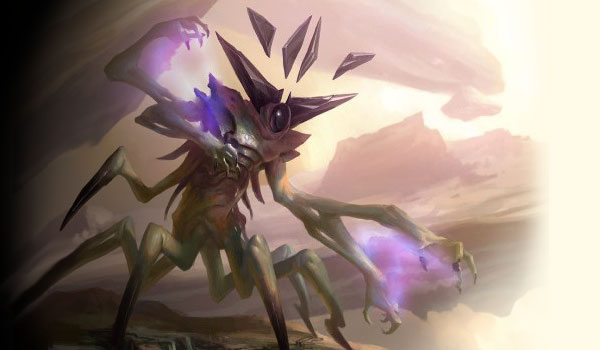
Most Modern players have resigned themselves to the Eldrazi's (hopefully temporary) dominance, either joining forces to create hundreds of Eldrazi Scion tokens or fighting back with increasingly esoteric sideboard technology and fringe deck choices. There also remains a small but stubborn cadre of Eldrazi defenders. On the one hand, I admire their confidence in Modern's ability to self-regulate, and agree with their pleas for banning patience. On the other hand, I am deeply suspicious of anyone who can look at these metagame numbers and see anything other than a real Modern horror story. As today's Louisville-specific and format-wide numbers show, the Eldrazi have dominated Modern at all points since the Pro Tour. They have adapted to win the mirror, grown to beat the hate, and evolved to stay leaps and bounds ahead of the competition. The question is no longer "Can Eldrazi be beaten?" It's "How much worse can the Eldrazi get?"
[wp_ad_camp_1]
SCG Louisville Debrief
Before we get to our metagame-wide breakdown, we need to make a painful stopover at the devastation that was SCG Louisville. Louisville was a critical, pre-Grand Prix datapoint for a few reasons. First, it would show if Modern players were willing to pick up Eldrazi in paper at the same rate they had done so online. Second, with 725 players, it would be the largest proving ground for Eldrazi pilots and Eldrazi slayers yet. Finally, with practically every single Modern article since Pro Tour Oath covering the Eldrazi crisis, it was the first big event where players knew what they were up against and could come prepared. Turnaround was possible! I'm reminded of the October 26, 2014 SCG Premier IQ in Minneapolis, which saw a good deal of Treasure Cruise, but also plenty of decks that weren't packing the offensive new toy from Khans.
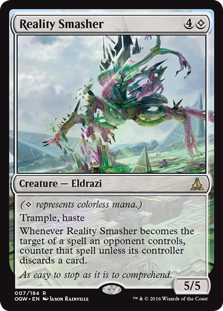 Did SCG Louisville reverse the narrative or challenge the Eldrazi's offense? Was our format reality unsmashed after the decisive Modern stand? The Top 32 numbers tell the tale of the tape!
Did SCG Louisville reverse the narrative or challenge the Eldrazi's offense? Was our format reality unsmashed after the decisive Modern stand? The Top 32 numbers tell the tale of the tape!
- Top 4 Eldrazi: 75% (3/4)
- Top 8 Eldrazi: 50% (4/8)
- Top 9-16 Eldrazi: 88% (7/8)
- Top 16 Eldrazi: 69% (11/16)
- Top 17-32 Eldrazi: 57% (9/16)
- Top 32 Eldrazi: 63% (20/32)
Gatewatch save us... Maybe the Day 2 numbers are better?
- Day 2 Eldrazi: 48% (31/64)
- Day 2 to Top 32 Eldrazi conversion: 65% (20/31)
- Day 2 to Top 16 Eldrazi conversion: 35% (11/31)
- Day 2 to Top 8 Eldrazi conversion: 13% (4/31)
If your reaction consists of just KappaHD and/or MiniK, we're basically on the same page.
 Twitch humor aside (and who doesn't love a dose of Twitch humor, channel mods excluded?), this is the exact opposite of what we wanted to see at SCG Louisville. We've seen the popular narrative of an unbeatable deck before: Amulet Bloom, Burn, Tron, and Affinity all come to mind from last year alone. In all those cases, the metagame resisted, whether through the Blood Moons at Grand Prix Charlotte or the Fulminator Mages of late 2015. Amulet Bloom eventually ate the ban, but that was for violating the turn four rule, not for warping the metagame and reducing format diversity. In all those cases, Modern players resisted the myth of an unstoppable deck through smart deckbuilding and nimble metagaming. Even when a card or deck was truly broken, as in the Treasure Cruise and Birthing Pod case of 2014-2015, players still gravitated towards other strategies and metagame numbers never looked like those at Louisville.
Twitch humor aside (and who doesn't love a dose of Twitch humor, channel mods excluded?), this is the exact opposite of what we wanted to see at SCG Louisville. We've seen the popular narrative of an unbeatable deck before: Amulet Bloom, Burn, Tron, and Affinity all come to mind from last year alone. In all those cases, the metagame resisted, whether through the Blood Moons at Grand Prix Charlotte or the Fulminator Mages of late 2015. Amulet Bloom eventually ate the ban, but that was for violating the turn four rule, not for warping the metagame and reducing format diversity. In all those cases, Modern players resisted the myth of an unstoppable deck through smart deckbuilding and nimble metagaming. Even when a card or deck was truly broken, as in the Treasure Cruise and Birthing Pod case of 2014-2015, players still gravitated towards other strategies and metagame numbers never looked like those at Louisville.
SCG Louisville is a convincing case study that Eldrazi is immune to this kind of regulation. Modern 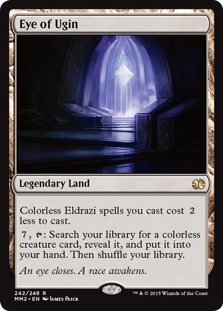 has never recorded a 500+ player event with a single deck claiming 50% of Day 2 and 63% of the Top 32, let alone with a 65% conversion rate that parallels the deck's Pro Tour conversion rates. Some Eldrazi sympathizers will point to the deck's overwhelming hype as a confounding variable in this analysis. They will allege the deck is still beatable but players aren't trying to beat Eldrazi because, in the short-term, it's easier to play it than defeat it. We should reject this argument for two reasons. First, the numbers actually exceed those of all previously broken decks over any single event in their reigns. This includes Bloodbraid Jund, which peaked around 30% in a Pro Tour, Deathrite BGx at 20%-25%, and Pod and Delver in the low 20% each. 48% is utterly unprecedented. Second, even ignoring those numbers, the mass player unwillingness to switch decks on its own is a problem. No other deck in Modern's history has commanded this blind obedience, which points to a singular monster and not just another Modern hype train.
has never recorded a 500+ player event with a single deck claiming 50% of Day 2 and 63% of the Top 32, let alone with a 65% conversion rate that parallels the deck's Pro Tour conversion rates. Some Eldrazi sympathizers will point to the deck's overwhelming hype as a confounding variable in this analysis. They will allege the deck is still beatable but players aren't trying to beat Eldrazi because, in the short-term, it's easier to play it than defeat it. We should reject this argument for two reasons. First, the numbers actually exceed those of all previously broken decks over any single event in their reigns. This includes Bloodbraid Jund, which peaked around 30% in a Pro Tour, Deathrite BGx at 20%-25%, and Pod and Delver in the low 20% each. 48% is utterly unprecedented. Second, even ignoring those numbers, the mass player unwillingness to switch decks on its own is a problem. No other deck in Modern's history has commanded this blind obedience, which points to a singular monster and not just another Modern hype train.
Careful analysts of the Louisville data will note Affinity's performance as a possible upset to Eldrazi's success. Although the robots did not appear in nearly the same raw magnitude as Eldrazi, they nonetheless boasted impressive finish rates.
- Day 2 Affinity: 8% (5/64)
- Day 2 to Top 32 Affinity conversion: 100% (5/5)
- Day 2 to Top 16 Affinity conversion: 60% (3/5)
- Day 2 to Top 8 Affinity conversion: 40% (2/5)
 Austin Holcomb won Louisville with his heavily metagamed Affinity list, packing maindecked Dispatch and sideboarded Ensnaring Bridge, even if he forgot to Bolt/Galvanic Blast the Bird en route to his victory. Do Affinity's numbers, which exceed Eldrazi's, suggest players have overestimated the format's problems? It's a trap! Do not mistake Affinity's performance as a sign of Eldrazi's weakness or impending downfall at Grand Prix Detroit. If anything, the two-story Modern town of 50% Eldrazi and 10% Affinity is one the most damning signs of metagame imbalance yet.
Austin Holcomb won Louisville with his heavily metagamed Affinity list, packing maindecked Dispatch and sideboarded Ensnaring Bridge, even if he forgot to Bolt/Galvanic Blast the Bird en route to his victory. Do Affinity's numbers, which exceed Eldrazi's, suggest players have overestimated the format's problems? It's a trap! Do not mistake Affinity's performance as a sign of Eldrazi's weakness or impending downfall at Grand Prix Detroit. If anything, the two-story Modern town of 50% Eldrazi and 10% Affinity is one the most damning signs of metagame imbalance yet.
For one, numerous pros have already attested to the lopsided Affinity vs. Eldrazi matchup. Between this qualitative knowledge and the quantitative indicators (from the Pro Tour to MTGO and subsequent paper events), everyone knew Affinity was where you wanted to be against Eldrazi. That or UW Eldrazi, but we'll ignore those colluders for now. Despite this prevailing wisdom, a measly five players made Day 2 on the deck. We know Affinity is a Modern-regular. We also know Affinity reliably shows up in the 10%-12% range at events and format-wide. For it to only appear at 7.8% suggests the common wisdom of Affinity being the best anti-Eldrazi option is either not being believed or not actually holding up in practice. Either way, the format is not correcting like it should, which suggests a deeper issue with the imbalance.
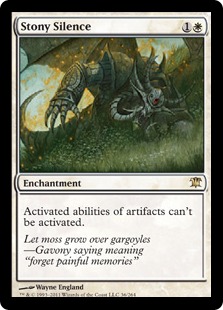 Two, the Eldrazi decks themselves have adapted (and keep adapting) to the Affinity challenge. Kent Ketter's UW Eldrazi may have lost to Holcomb in the Louisville finals, but his three Stony Silences and two Disenchants represent a strategy-wide shift to Affinity-busting technology. We also see this in RG Eldrazi lists, as exemplified by Alex Zurawski's fifth place build. Between three each of Ancient Grudge, Natural State, and Lightning Bolt in the sideboard (plus four Kozilek's Return in the main 60), RG Eldrazi is more than prepared for Affinity. This is likely reflected in the Day 2 numbers, with UW Eldrazi picking up percentage points for both the mirror and an improved Affinity matchup. When your best police deck is so easily counter-policed, the format is in trouble.
Two, the Eldrazi decks themselves have adapted (and keep adapting) to the Affinity challenge. Kent Ketter's UW Eldrazi may have lost to Holcomb in the Louisville finals, but his three Stony Silences and two Disenchants represent a strategy-wide shift to Affinity-busting technology. We also see this in RG Eldrazi lists, as exemplified by Alex Zurawski's fifth place build. Between three each of Ancient Grudge, Natural State, and Lightning Bolt in the sideboard (plus four Kozilek's Return in the main 60), RG Eldrazi is more than prepared for Affinity. This is likely reflected in the Day 2 numbers, with UW Eldrazi picking up percentage points for both the mirror and an improved Affinity matchup. When your best police deck is so easily counter-policed, the format is in trouble.
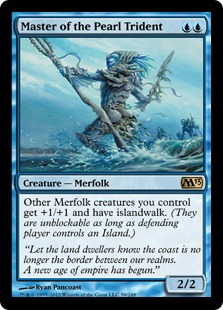 As a final point on the Louisville disaster, consider the non-Affinity and non-Eldrazi decks that made Day 2. I haven't said much about them so far because, well, there's not much to say. Infect, Merfolk, and Abzan Company all posted decent 4%-6% shares, with a scattering of other strategies represented throughout the breakdown. Of those, we saw lone showings by Kiki Chord, Jund, Merfolk, Skred Red, UW Control, Blue Moon, and Scapeshift in the Top 32. Only Merfolk got Top 8 or Top 16 and Infect didn't even crack Top 32.
As a final point on the Louisville disaster, consider the non-Affinity and non-Eldrazi decks that made Day 2. I haven't said much about them so far because, well, there's not much to say. Infect, Merfolk, and Abzan Company all posted decent 4%-6% shares, with a scattering of other strategies represented throughout the breakdown. Of those, we saw lone showings by Kiki Chord, Jund, Merfolk, Skred Red, UW Control, Blue Moon, and Scapeshift in the Top 32. Only Merfolk got Top 8 or Top 16 and Infect didn't even crack Top 32.
Calling this an anemic performance by the Modern traditionalists would be like lauding Ben Carson's Nevada run as a comeback: it dramatically overstates just how poorly these decks performed. This illustrates two further problems with Louisville. First, that outside of Affinity there is no deck which can put up a meaningful fight against Eldrazi, and second, that a host of historical Modern decks are nowhere to be seen. Zoo, Tron, Grixis, Abzan, Living End, and others are conspicuously absent or diminished in Day 2, and outright gone from the Top 32. That's a startling lack of diversity which we haven't seen in even the most warped eras of Modern to-date.
Taken both on its own and in the format's broader context (which we are about to revisit in all its otherworldly splendor), SCG Louisville was Modern at its worst. Eldrazi obliterated the competition, Affinity showed itself to be the only legitimate alternative, and everyone else floundered in obscurity. I'd be less forceful in my Louisville analysis if this were the first time we'd seen this story play out. But having watched it in the Pro Tour and in the two weeks following, the narrative was just too consistent and compelling to ignore as it played out in Louisville. Moreover, as we will see soon, it has also continued to govern Modern as a whole.
Adding Datapoints
In most Modern metagames, additional data often means a more normalized format. We've increased our 2/5 to present dataset and will see if this normalization holds true today (spoiler alert: prepare to have your hopes drowned). In last week's metagame check-in, we had about 20 MTGO events with around 210 decks, on top of 34 paper tournaments contributing 270 extra lists. Today, we're up to 32 MTGO Leagues and 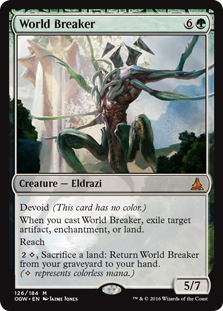 Dailies and 316 decks. The paper dataset grew to 46 events and just under 350 deck-entries, not to mention all the SCG Louisville action joining with the existing Pro Tour stats to flesh out our "major paper" and Day 2 side of the numbers. Taken as a whole, that's about half the datapoints we'd normally expect for a proper metagame update, although I fully expect we'll get there by the March Grand Prix weekend.
Dailies and 316 decks. The paper dataset grew to 46 events and just under 350 deck-entries, not to mention all the SCG Louisville action joining with the existing Pro Tour stats to flesh out our "major paper" and Day 2 side of the numbers. Taken as a whole, that's about half the datapoints we'd normally expect for a proper metagame update, although I fully expect we'll get there by the March Grand Prix weekend.
As with all previous metagame breakdowns, we're using an adjusted metagame averages to account for both the smaller N between different categories in the dataset (e.g. MTGO has fewer events than does paper), and the smaller N relative to our usual monthly breakdowns (e.g. we'd expect paper to have about 100 events, not 50, for an update). When our sample size increases, as it did this week, we can be more confident the sample itself is representative. Weights will change to reflect that. Even if you care as much about statistics as World Breaker does about Worship, it's enough to know our weekly Eldrazi updates are getting more accurate by the day. Given how warped the numbers are, that's bad news for Moderners everywhere.
Post-Louisville Metagame Summary
If SCG Louisville is the focused, case study illustration of Eldrazi dominance, the metagame-wide figures represent the broader scoop. Deck shares are even more imbalanced than they were last week, which both reflects the increased sample size (which removes some uncertainty around our estimations) and the Eldrazi solidifying their Modern foothold. I'll spend a little time in each tier to reexamine the statuses of certain decks and metagame forces, but for the most part, I'll let the numbers speak for themselves.
Here's Tier 1, aka Eldrazi plus everything else. As per our Top Decks definitions, these are the decks you are likely to play against at tournaments and need to test against if you are serious about winning. I'm adding a column to show the change in metagame share relative to last week's update.
Tier 1: 2/5/16 - 2/22/16
Get 'em Merfolk! Show those Eldrazi who rules these waves! Just kidding: those are Drowner of Hope's seas. Outside of Merfolk's paltry .5% rise from Tier 2 into Tier 1, the Eldrazi have absolutely suffocated the tier of most other meaningful options. Our format Engima is up an astounding 5.3% with literally every single Tier 1 strategy down  or flat. How does a deck already at 25% of the format jump up yet another 5%? Ask Eldrazi Displacer and its Louisville pals, who cemented Eldrazi's Tier 0 status just as they secured the Eldrazi mirror. Affinity's share retreated in MTGO and Day 2 while picking up .4% in paper, an overall loss for the deck supposedly keeping us safe.
or flat. How does a deck already at 25% of the format jump up yet another 5%? Ask Eldrazi Displacer and its Louisville pals, who cemented Eldrazi's Tier 0 status just as they secured the Eldrazi mirror. Affinity's share retreated in MTGO and Day 2 while picking up .4% in paper, an overall loss for the deck supposedly keeping us safe.
Are these non-Eldrazi Tier 1 decks still viable at a competitive level? Yes, but to a much lesser degree today than we witnessed in early January. With proper sideboard and maindeck adjustments, any of the Tier 1 decks are probably capable of combating, even defeating, Modern's Eldrazi tyrants in individual games. At the metagame-wide level, however, the Tier 1 decks continue to prove unequal to the 30% monstrosity. Expect to see more Eldrazi decks dabbling in increasingly niche splashes and technology to gain edges in the mirror while also preserving their broken core.
Tier 2 is up next, representing competitive decks in the current metagame, but not ones you need to prepare against in the maindeck or the sideboard. That said, you'll still need to know the fundamental strategies behind each deck, even if you're not necessarily angling towards decks with positive Tier 2 matchups. Thankfully, although Tier 1 got worse this week relative to our previous update, Tier 2 enjoyed some tiny improvements.
Tier 2: 2/5/16-2/22/16
First, the bad news: we still only have six decks in Tier 2. As I talked about last week, that's a major problem for a format that averaged 13 Tier 2 decks throughout 2015, with no update ever featuring fewer than 11. As we saw at SCG Louisville, the Eldrazi have pushed these decks out of competitive viability, narrowing the format in an unprecedented fashion. For those of you who have held out for good news, Tier 2 does offer some small consolations. Naya Company may have fallen out of Tier 2 contention, but it has been replaced by a pair of blue-based control decks with considerable anti-Eldrazi game: Blue Moon and UW Control. We all remember Blue Moon master Jason Chung and his memorable Pro Tour Oath run from a few weeks ago. Chung's and his team's Blue Moon core of Blood Moon, Batterskull, Pia and Kiran Nalaar, and Snapcaster Mage may have fallen short of Top 8 glory at the Pro Tour, but its making a respectable comeback into Tier 2 for this week.
It's joined by UW Control, a highly reactive and deeply traditional control strategy not even the most old-school Counterspell mages can reject. In the immediate 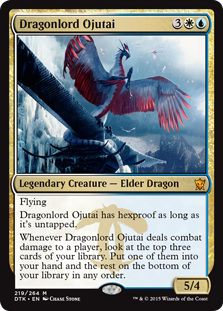 aftermath of the Pro Tour, I identified UW Control as one of the best anti-Eldrazi strategies with past Tier 1 or Tier 2 showings, and players across both paper and MTGO venues have proven this prediction to be an accurate one. Notable online UW Control finishes include IwalkAlone's and manaflood's 2nd and 3rd place respectively at a 2/14 and 2/6 Pro Tour Qualifier respectively. Both pilots used powerful countermagic and removal (even a pair of my pet Flickerwisps!) to overcome a field that was disproportionately Eldrazi. For paper, we applaud Riccardo Biava's win at a 2/14 StarCityGames Qualifier in Milan. Biava beat not one but two Eldrazi decks in the Top 8 alone, preferring a Dragonlord Ojutai and Jace, Vryn's Prodigy addition to UW Control's conventional three Cryptic Commands and three Supreme Verdicts.
aftermath of the Pro Tour, I identified UW Control as one of the best anti-Eldrazi strategies with past Tier 1 or Tier 2 showings, and players across both paper and MTGO venues have proven this prediction to be an accurate one. Notable online UW Control finishes include IwalkAlone's and manaflood's 2nd and 3rd place respectively at a 2/14 and 2/6 Pro Tour Qualifier respectively. Both pilots used powerful countermagic and removal (even a pair of my pet Flickerwisps!) to overcome a field that was disproportionately Eldrazi. For paper, we applaud Riccardo Biava's win at a 2/14 StarCityGames Qualifier in Milan. Biava beat not one but two Eldrazi decks in the Top 8 alone, preferring a Dragonlord Ojutai and Jace, Vryn's Prodigy addition to UW Control's conventional three Cryptic Commands and three Supreme Verdicts.
It's good to see more color and card diversity in Tier 2, even if the overall Tier 2 picture is still bleak, and even if Gruul Zoo is a Tier 2 deck when the much more enduring Naya Company can't cut it. Talk about a canary in the Modern coal mine! Blue's return to Tier 2 viability suggest the tier as a whole might open up as we near the Grand Prix, which would be a small victory for Modern diversity in a string of metagame defeats.
Finally, we end with Tier 3, the metagame calls and fringe-viable decks you should consider for specific events. As with last week's Tier 3 options, you'll want to pay special attention to metagame shares within each column. A deck might enjoy unusual viability on MTGO while seeing no paper presence at all. Martyr Proc fits this mold perfectly. You'll also see decks with a 0% MTGO share and a sizable paper following, such as Elves and some URx Delver variants.
Tier 3: 2/5/16 - 2/22/16
Tier 3 is always going to be relatively open, even if Tier 1 is burning above. That said, Tier 3 remains unusual in this time period with its concentration of historically Tier 2 decks. For instance, Living End, Elves, Naya Company, Scapeshift, and the Grixis Control/Midrange players are all relegated to Tier 3 despite their typical presence in Tier 2. Metagame change and shifts are good for Modern, but the abrupt and simultaneous downfall of these strategies suggests a bigger problem. The 30% Eldrazi specter looming over the 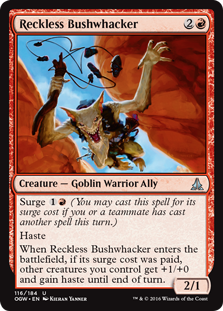 format doesn't make this narrative any prettier. As a player, consider the Tier 3 decks as niche options depending on your playstyle and preference. All of these decks have beaten Eldrazi opponents to even reach this point, which might make them feasible choices for upcoming events. Brave enough to rally your Reckless Bushwacker Goblins through a Grand Prix field? Hit me up for a feature piece, especially if you piledrive into Day 2.
format doesn't make this narrative any prettier. As a player, consider the Tier 3 decks as niche options depending on your playstyle and preference. All of these decks have beaten Eldrazi opponents to even reach this point, which might make them feasible choices for upcoming events. Brave enough to rally your Reckless Bushwacker Goblins through a Grand Prix field? Hit me up for a feature piece, especially if you piledrive into Day 2.
In all three tiers, especially the Dismembered Tier 1 listings, we see the direct and indirect effects of the Eldrazi invasion. These forces are so overpowering that it is hard to imagine a Grand Prix weekend that isn't as twisted as the format we see today. Lower attendance, fear of bans, and genuine innovation might mitigate the Eldrazi's advances on the Grand Prix stage, but I suspect the overall image will still be all Eldrazi all the time. The pre-trends are too dominant to suggest anything else.
More Eldrazi to Come?
I can't promise we'll see the end of the Eldrazi any time soon, either in the overall metagame or on Modern Nexus. I've had some people ask me why we keep posting about Eldrazi, which is a fair question given how much we've written on them, how much others have already discussed the topic, and how much most Moderners hate our new colorless masters. Quite frankly, it's disingenuous to do otherwise on a site dedicated to Modern. Modern is the Eldrazi right now; it's impossible for a deck with a 30% share to not affect every element of the format. That said, we'll keep up the pattern we held last week, with at least 1-2 articles per five-day period deviating from the Eldrazi hegemony and discussing awesome Modern possibilities like Enduring Ideal prison decks and post-April metagame optimism. I also have a series of Modern management and policy-themed pieces planned for March, which I'm very excited to share once the Grand Prix weekend is in the books.
Modern is a mess right now, but with the possibility of an emergency ban seemingly (and rightfully) off the table, we'll have to endure the takeover for a little over a month. I'll check back in with the metagame next Wednesday and will have something more Eldrazi-free on Monday for all of us to enjoy. Until then, I look forward to seeing all of you in our newly moderated comment section and to talking about the format, the numbers, where we go from here, and how the heck we are supposed to salvage our Grand Prix plans. See you all soon!





I have to admit, that’s a grim metagame picture we’re facing as of now. Even the decks that can compete against the Eldrazi can’t gain enough footing to drive down the metagame share. I’m going to dig in my heels and keep fighting them as best I can, but I think the message is depressingly clear: their core is just better than everyone else’s.
It’s pretty bad and I see no sign of improvement until at least the GP (and even that is a faint hope). I’m unlikely to attend GP Detroit as a result, although I admit it wasn’t a sure thing anyway, but I’ll probably post some test results next week to give people an idea of where I was going into the event.
Welp, it’s a long time ’til April; may as well keep on brewin’.
Agreed. It’s fairly embarrassing sleeving up a delver of secrets these days. Do most brews you create end up attacking and taxing their mana? I have three lists all based around that idea; Rw, Rb, and a Blue Moon brew featuring Silumgar’s Scorn are my three pet projects right now.
Personally, I don’t bother attacking the manabase; I think that’s a red herring. Even *if* you’re able to keep them off their first couple of plays with mana disruption, all you’ve done is delay their plays by a couple of turns. Since you’ve spent your own first couple of turns making that delay happen, what have you actually accomplished? You’re in the same situation as you would have been at turn 1 without the disruption, except you’re running low on cards now.
Instead, ignore the mana and deal with what they’re actually doing: playing high-impact creatures and attacking. Find efficient ways to dealing with those. Keep the Seer or Smasher from hitting the battlefield, via Thoughtseize or Tidehollow Sculler or Mana Leak. Bypass the value abilities of Smasher or Reshaper via Journey to Nowhere. Slow down the combats efficiently with Wall of Omens and Kitchen Finks so you can last long enough to sweep when their hand’s empty, then use a good draw spell to reload and take control of the game.
As broken as the deck is, you’ll do much better if you remember that it’s not a ramp deck; it’s an aggro deck.
Remember the wisdom of the most interesting man in the world:
“I don’t always beat Eldrazi; but when I do, I’m not attacking their mana.”
Agree with Jacob that you shouldn’t worry about the mana unless it’s en route to doing other things (e.g. Seas as a cantrip). Attacking their creatures works, as we saw with UW Control. Abzan Company does well too, combining a value-oriented creature plan with a combo Plan B. I’d avoid pure synergy-based decks, as TKS, Dismember, and Path screw those up too much, and I’d avoid things like Delver that try to get small edges; the Eldrazi are just too powerful for those decks to fight.
That’s what I’ll be doing until then! Although at a certain point, I’m transitioning to my high-level Modern policy/management series, or brewing in anticipation of the eventual ban. No reason to assume we’ll be living under the Eldrazi shadow in April at this rate…
Given the power and results the Eldrazi decks are posting, is there any argument to keep anything but itself and (possibly) affinity as tier 1?
Just seems that the deck is that good, head and shoulders, above the rest.
Oh, UW Eldrazi seems to be the thing in the mirror. I guess we finally figured out the blue deck Twin was keeping out of modern.
Although I’m not playing modern since twin’s ban, I intended to keep an eye in the format and see what was happening. Even that is getting stale quite quickly…
Honestly, Eldrazi is Tier 0 and the rest are all Tier 1. Future updates will probably reflect that, once we have enough data from the GPs. Or maybe Eldrazi gets reined in and the share drops down low enough to not be Tier 0. We’ll have to wait and see! My guess is we see an April ban, HOPEFULLY an April unban as an apology (although I can see Wizards wanting to wait and see because they are overly cautious), and the format ending up to be just fine.
I really wants to believe this could lead to some unbans. I personally really hope Stoneforge gets a chance. But unfortunatly I think this will be prompt the exact opposite. I think they will be extremely conservative going forward fearing a broken meta again.
And if anything gets unbanned I will be shocked If its not visions – though I hope im wrong.
I’m sorry but April is too long. I have never been one to hope on a ban train, but these numbers are too ridiculous. To make matters worse? I have a strong feeling this isn’t the end, we will continue to see more and more eldrazi. When other dominate decks have entered a format I have never felt quite as helpless as I do towards this modern eldrazi. Coverage is suddenly less appealing, playing is less appealing, and I find my interest in the format dwindling.
Hop* on a ban train.
Forsythe and the rest of Wizards are right to wait. Modern is likely to recover from the Eldrazi dominance and be totally fine by June, assuming a much-needed April ban. But an emergency ban would set a terrible precedent. It’s only been done once in the game’s history under a totally different set of circumstances. Not even Affinity or Caw Blade warranted an emergency ban. Wizards doesn’t need to add even more ban mania to Modern by doing this, and I applaud them for waiting. The risks are too high and the costs of waiting are relatively low.
Good article dude. I’m glad you addressed the aspects of banning guide lines such as Format Warping/Lack of Diversity and Violating the Turn 3/4 Kill rule. Whether it be meta-game shares that a deck holds or a single card being an auto-include in every deck in modern (looking at you Mental Misstep) Eldrazi is currently warping the crap out of the format. Despite Eldrazi having yet to find its best color pairings, as someone above mentioned, at its core, I fear its the best deck in modern right now. After watching a Channel Fireball video I think the safest ban will be Temple. You can’t stack Eyes like you can Temples allowing for T2 TKS or a Reality Smasher w/ a Spirit Guide. They might get lucky and live the dream by puke out 3x Mimics T1 off an Eye but they won’t be crashing in for 12-15 dmg T3 anymore w/ Temple gone.
Conclusion: #BanTemple
I think this is the most sensible target for a ban. Eye has utility in other decks, Temple does not. T2 Thought-Knot Seer followed by T3 Reality Smasher (the real backbreaker the deck has access to) doesn’t happen without Temple. Let them have an Affinity-esque T1 – those creatures don’t have evasion, don’t do that much damage unassisted, and they can overall be dealt with. The deck gets a lot less scary (while staying potent) without the Temple.
See the funny thing is, as adamant as I have been against the current iteration of eldrazi, I do think the archetype is cool and doing something unlike any other in modern, so i would like to see it survive and I think t1 mimic into t2 thought knot is a nut draw that I’m ok with because you can at least interact with mimic if it’s only one. Eye just breaks the deck in half mostly because it give the deck massive inevitability.
Eye is the reason board wipes, thoughtseize and mana leak are sub par answers. Sure they deal with the explosive starts, but the deck is good because it top decks better than Jund. I honestly could care less about a t4 sweeper if I get to follow up with t5 endbringer, t6 smasher to hit for 11. Or t5 smasher to immediately pressure after the wipe and then chill until I get enough lands to literally drop threats every turn…
I find your ideas rather bizarre, boogelawoof. You acknowledge T1 Mimic into T2 Seer as a “nut draw”, but regard Eldrazi following up a Wrath effect with perfectly on-curve threats for turns 4-6 or so as being consistent enough to build an argument around. That seems like a mind-boggling double standard. They have at least a little bit of control over their opener (via mulligans), but by turn 4 they’ve emptied or nearly emptied their hands, and their draw steps have a lot of “duds” they can hit: SSG, Chalice, Gut Shot, Mimic, Eyes #2-4, plus just plain old extra lands like everyone else.
It’d be neat if somebody could do the math to see the odds of getting the “nut draw” you defined and compare it to the odds of the kind of topdecks you’re describing. I imagine it’s a lot more likely to face a Mimic/Seer opener than to see a Wrath get followed by a series of late-game powerhouses.
I would also point out that “until I have enough lands to literally drop threats every turn” is like, what, ten lands? After all, none of the “sol lands” help with that 7-mana tutor, so you need 8 lands plus however much it takes to cast your threat. That’s enough lands that anyone who let Eldrazi get there without finishing the game deserves what’s coming.
Jacob, thanks for your reply and let me explain.
The first key problem with your comment is that you assume I’m only talking about the colorless version (with its top deck chalices and what not). Granted, my reference to end bringer may point you in that direction, but also recognize that against the decks where inevitability matter (midrange and control, basically any deck that isn’t trying to win fast or combo you out) the chaff you point to is removed after sideboard and you are indeed top decking gas the entire time. As for the other builds of eldrazi, let’s just say drowner/worldbreaker etc are better top decks than anything Jund can muster (and we are 4 of a lot of these threats, Jund usually just 1 of a 4 drop or whatever). Also, the ten lands thing, you will definitely get that far against the kinds of decks I described, and when you do, dropping something, albeit just a mimic for free of the eye, can prove troublesome of you are doing it every turn.
But I guess that just goes to show what I mean: perhaps my argument of “this deck has aggressive nut draws but also game winning inevitability” sounds so strange because the deck is actually busted beyond belief.
Btw, if I haven’t addressed your points or you are still having trouble with my post, it’s also possible I did not understand yours, so let me know if I didn’t address your questions
Just as a follow up to this, and I know it’s anecdotal, but it will illustrate what I’m talking about.
Last night played against u/w Titan control. I actually really liked the deck. Ran flicker wisp (probably as a two of) and super sweet phantasmal image tech. First game I nut drew eye of ugin and 2 endless ones t1 into t2 thought knot t3 smasher. Unbeatable. Game 2 they went off. Image copying thought knot is pretty sweet even if the image is fragile. But it got even dirtier as the game went on because their Titan brought back image copying Titan bringing back flicker wisp on the original Titan bringing back wall of omens. This was the turn or two after a sweeper. Literally build your own army with 1 Titan.
Game 3, though exemplifies what I’m talking about in my previous post, though. I get on board starting from t1 mimic off a temple into various other drops ending in a oblivion sower. They wrath and I immediately drop smasher plus activate mutavault to get in for 7. They stabilize next turn with an illusion copying sower, but I just leave mana open to tutor an endbringer off eye. I (luckily) rip a dismember so I bait two leaks in the enbringer and then dismember their image after they tap out to swing for lethal. Again, anecdotal, but exemplary of the type of games that play out. I should also mention that I thought knotted a path somewhere in game three and played around the mana leak for the rest of the game.
Lastly, while not close to twin in the combo respect, reality smasher does provide that same “am I dead next turn” feeling that you have to take into account when deciding to leave back blockers or keep a card to pitch to removal on smasher.
It’s funny how contentious the eye vs temple argument is. I personally have been in the eye train since the beginning. At first because of the puking out your hand reason, but quickly changed to inevitability reasons after actually playing the deck. That said, eye itself is pretty bad in the first couple of turns if you are not dropping a bunch of mimics and endless ones.
Again, my main argument is that curved out draws, though with only one creature a turn, are more manageable than 2-3 creatures on turn one. I think the fact that eye gives he deck the same kind of inevitability as tron is really the deal breaker over temple
There’s an interesting debate about the Temple vs. Eye issue. On the one hand, Temple leads to the most consistently problematic plays, like T2 Seer and T3 Drowner. On the other hand, Eye leads to the most explosive plays, like T1 Mimic/Endless One vomits. I can see Wizards hating both for different reasons. Honestly, they might just ban both, following the Caw Blade SFM/JTMS ban, the Affinity Ravager/Lands ban, and the Delver TC/DTT ban models. The precedent is definitely there!
I agree with this and hadn’t thought about it really until you list them out like that. Certainly precedent. Though it will make me sad if they ban both. I really do think eldrazi would be a cool addition to the metagame if it wasn’t so oppressive. I do think that with all the meta gaming that’s been happening, modern could contain a one-sol-land eldrazi deck
That is honestly what I expected to happen since I first saw the Pro Tour results, and yes, precedent is absolutely the best explanation. They need to **put the brakes on** this monster and then re-evaluate. They can always try unbanning one of them later if the new data permits it.
One other reason to can both: Public Relations. There are folks quitting Modern over this. They can’t just replace them overnight but by taking an obvious FULL Measure here and not a tentative, cautious ‘half measure’ (i.,e. banning only one) they send a stronger signal to the quitters. And then they also can avoid any community grumblings of “Oh my God, they f’d up the banning too…NO HELP AT ALL, THANKS WIZARDS!!!!” >:( And then they lose a ton MORE players, fairly or (probably) not. So yeah, just rip the Band Aid off completely, get it over with. And then leave this controversy behind in the dust.
I’m glad that this happened to Modern in a sense because at least now there will be a new loathsome metagame to serve as a touchstone for players, rather than Caw-Blade Standard.
I’m still salty about ravager affinity in standard and extended. Some day I’ll move on to complaining that the skill testing caw blade metagame is gone.
True! It will also hopefully create enough incentive for Wizards to start testing for Modern, something they desperately need to do.
Looks like a healthy metagame to me. I don’t see the problem kappa.
Yes! Very fair and balanced KappaHD
So, assuming they ban eye and leave the temple intact do you see vesuva as a replacement? Vesuva can still lead to a turn 3 smasher via eye / vesuva / land vs the current eye / temple / land, however the overall velocity comes down as turn two is spent with a tapped vesuva and the eldrazi player is restricted to one mimic per turn off the temple. That turn gives a window to a control player to setup for a mana leak or at least have an additional turn to find a sweeper or removal. That extra turn could also be the difference a deck like zoo or infect need to be able to hold their own. While I certainly see the current meta pointing to eldrazi as overpowered nuking the entire archetype would to me be a loss and out of line with recent bans. Bloom for example was not totally nutuered by banning both amulet and summer bloom. Having a true mud/stompy style deck that fits within the meta, rather than totally warping it, would to me be a success forward expanding modern archetypes.
This
Clearly the lands are the enablers, but I can’t help feeling like an April ban will end up being the death of Eldrazi in Modern.
If it’s another deck archetype, it adds to the format, which I’m all for.
When it warps the meta to the extent we are seeing then my enthusiasm wanes. But that said my enthusiasm for modern waned when I was playing against three different twin decks and burn every time I sleeved up my latest janky combo deck too.
What I’d hate to see in Modern is the most popular/hated/winning-est deck get a card or two taken off them every ban season rolls around.
I think in the case of Eldrazi you have to look at banning Eye of Ugin, just because it’s a flat reduction in costs, it doesn’t tap. Over two turns it can effectively “generate” (for want of a more accurate term) 4 mana (or more in very good hands) on turn two. I am assuming one eldrazi mimic for free on turn one or two and 2 mana off any other eldrazi on turn two. We all know that isn’t the best opening Eldrazi has either.
I would also be willing to at least attempt a non-land solution (and I base this suggestion on looking over the deck lists and saying “hmm, that’s the one that puts them over the edge”) and I would line up Reality Smasher.
Eldrazi Mimic and Thought Knot Seer are good, really good truth be told, but they are both interact-able to some extent and they have no evasion to speak of. Reality Smasher, with it’s trample, haste and an auto 2-for-1 when it’s hit with targeted removal is the one I think is most damaging for the turn three plays of other modern decks.
I’m OK with there being a different tier one deck in the format. I just want to lose to a variety of decks with my heartless summoning/myr retriever/altar of the brood combo deck.